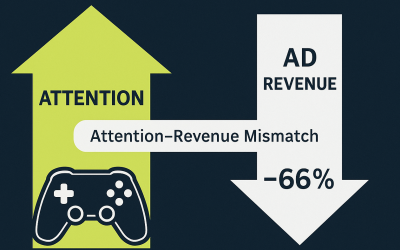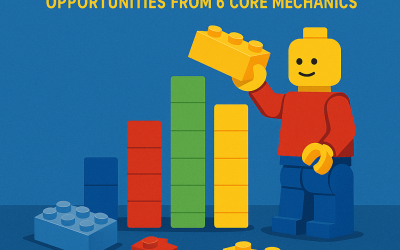The Gaming Industry’s Great Paradox
Rewarded video ads: The critical bridge between monetization and player satisfaction
The gaming industry stands at a crossroads that would have seemed impossible just a decade ago. In 2024, global gaming revenues hit a staggering $219 billion according to Bain & Company’s latest comprehensive survey—yet beneath these record-breaking numbers lies a troubling reality. Growth is decelerating, development costs are spiraling into the hundreds of millions, and the fundamental economics that have powered the industry for decades are crumbling.
Consider this paradox: today’s gamers are more engaged than ever before, spending countless hours in virtual worlds like Roblox, Fortnite, and Minecraft. Yet they’re paying less per hour of entertainment than at any point in gaming history. A blockbuster title that cost $60 in the 1990s would need to sell for over $100 today to match its inflation-adjusted value, while development budgets have exploded from millions to hundreds of millions of dollars.
This creates an unprecedented challenge for developers and publishers: how do you monetize a generation of players who expect games to be free, social, and constantly evolving? The answer may lie in an unlikely source—an advertising format that first proved itself in the mobile gaming trenches and is now poised to revolutionize the entire industry.
Enter rewarded video ads (RVAs): the monetization strategy that’s finally bridging the gap between player expectations and publisher revenue needs.
Contents
- 1 The Death of the Old Monetization Model
- 2 The Rewarded Video Revolution: Flipping Advertising on Its Head
- 3 The Data Tells a Compelling Story
- 4 Beyond Mobile: The Platform Gaming Revolution
- 5 The UGC Monetization Challenge
- 6 Case Study: Roblox’s Programmatic Transformation
- 7 Implementation Strategy: Making Rewarded Ads Work
- 8 The Technology Behind the Experience
- 9 Looking Forward: The Next Five Years
- 10 The Win-Win-Win Future of Gaming Monetization
The Death of the Old Monetization Model
For nearly three decades, the gaming industry operated on a beautifully simple model: create a game, sell it for a fixed price (typically $60-70), and generate additional revenue through sequels and expansions. This approach worked brilliantly when games were discrete products consumed individually.
But the rise of persistent virtual worlds changed everything. Today’s most successful games aren’t products—they’re platforms. They’re living, breathing ecosystems where players don’t just consume content; they create it, share it, and build communities around it. In this new paradigm, the old monetization model doesn’t just fail—it actively works against player engagement.
The industry’s response has been a series of increasingly desperate experiments:
Microtransactions became ubiquitous, but over-reliance on them has created a backlash. Players rightfully feel exploited when core gameplay features are locked behind paywalls, leading to the dreaded “pay-to-win” stigma that can kill a game’s community overnight.
Loot boxes offered a gambling-like thrill that initially drove massive revenues, but they’ve faced increasing regulatory scrutiny and player resentment. Several countries have banned them outright, and the negative publicity has made them toxic for many publishers.
Subscription services like Xbox Game Pass and PlayStation Plus have gained traction, but their economics remain unproven for mega-budget titles. When a game costs $200 million to develop, can it really thrive in a $10-per-month subscription model?
Traditional advertising has remained largely taboo outside of mobile gaming. Console and PC players have historically rejected any form of advertising integration, viewing it as a corruption of their premium gaming experience.
Each of these approaches faces fundamental limitations, leaving publishers caught between mounting development costs and increasingly resistant consumers. This is precisely the environment where rewarded video ads have found their moment to shine.
The Rewarded Video Revolution: Flipping Advertising on Its Head
Rewarded video ads represent a fundamental reimagining of the relationship between players and advertising. Instead of forcing interruptions or blocking content behind paywalls, RVAs create a genuine value exchange that respects player agency while delivering meaningful benefits.
The formula is elegantly simple: players voluntarily watch a 15-30 second advertisement in exchange for tangible in-game rewards. These might include virtual currency, extra lives, exclusive cosmetic items, time accelerators, or special abilities. The key word here is “voluntarily”—players maintain complete control over when and whether they engage with advertising content.
This opt-in approach addresses the core psychological barrier that has made traditional gaming advertising so problematic. When players feel forced to endure advertising, they experience it as a penalty—a tax on their entertainment time. But when they choose to engage with an ad in exchange for something they value, the same content becomes a reward mechanism.
The psychological shift is profound. Instead of “I have to watch this ad to continue playing,” the internal dialogue becomes “I can choose to watch this ad to enhance my experience.” This transformation from penalty to empowerment explains why rewarded video ads have achieved acceptance rates that would be impossible with traditional formats.
The Data Tells a Compelling Story
Bain & Company’s 2025 survey reveals the fascinating contradictions in player attitudes toward advertising that make rewarded video ads so powerful:
- 64% of players report that ads interrupt their gameplay experience (up 5 percentage points year-over-year)
- 46% admit they often make in-game purchases triggered by advertisements (up 6 percentage points year-over-year)
These seemingly contradictory statistics actually tell a coherent story: players don’t hate advertising—they hate bad advertising. They reject intrusive, irrelevant, or poorly timed ads that break immersion and add no value to their experience. But when advertising is integrated thoughtfully, timed appropriately, and offers genuine value, the same players not only accept it but actively engage with it.
Rewarded video ads thread this needle perfectly. They preserve immersion by integrating naturally into gameplay pauses—after a failed level, during loading screens, or at natural break points. They provide immediate, tangible value that enhances rather than interrupts the gaming experience. Most importantly, they respect player choice, eliminating the resentment that comes with forced advertising.
Beyond Mobile: The Platform Gaming Revolution
While rewarded video ads first proved their worth in mobile gaming juggernauts like Candy Crush, Clash of Clans, and Honor of Kings, 2024-2025 has marked their expansion into entirely new gaming territories. This evolution represents more than just format migration—it signals a fundamental shift in how the gaming industry thinks about advertising integration.
Roblox has emerged as the pioneer in this space, launching a comprehensive programmatic video-ad marketplace in partnership with PubMatic in 2024. But the real breakthrough came in 2025 with their Google partnership, which introduced sophisticated rewarded video formats that let players earn meaningful perks across the platform’s vast ecosystem of user-generated experiences.
The scale of this opportunity is staggering. With 97 million daily active users, Roblox offers advertising reach that rivals YouTube, but with the deep engagement levels that only gaming can provide. Players don’t just passively consume content on Roblox—they invest hours creating, sharing, and collaborating within its virtual worlds.
Fortnite and Minecraft are following similar trajectories, experimenting with branded experiences and rewarded content that blur the lines between advertising and gameplay. When a player in a custom Fortnite map chooses to watch a 30-second ad to unlock an exclusive weapon skin, they’re participating in a value exchange that benefits everyone involved: the player gets unique content, the advertiser gains engaged exposure, and the content creator earns revenue.
This triple-win dynamic is particularly powerful in user-generated content (UGC) ecosystems, where traditional monetization models often fail to adequately compensate creators while providing sustainable revenue streams for platforms.
The UGC Monetization Challenge
Platform-style games face unique monetization challenges that make rewarded video ads particularly attractive. Unlike traditional games with linear progression and clear endpoints, UGC platforms host thousands or even millions of individual experiences, each with different engagement patterns, player demographics, and monetization potential.
Consider the economics: in 2024, Roblox paid nearly $1 billion to its creator community, while Fortnite distributed over $350 million to content creators. These massive payouts demonstrate both the value these platforms generate and the complexity of monetizing them effectively.
Traditional monetization approaches struggle in this environment:
- Microtransactions must work across vastly different experience types, from racing games to social hangouts to educational simulations
- Subscription models can’t easily account for the varying value different players derive from different experiences
- Direct advertising becomes logistically nightmarish when scaled across millions of individual creator experiences
Rewarded video ads solve many of these problems elegantly:
- They scale naturally across diverse experience types and genres
- They reward both creators and players through revenue sharing and enhanced gameplay
- They align with the collaborative, opt-in nature of UGC platforms
- They provide measurable value that can be tracked and optimized across different experiences
Case Study: Roblox’s Programmatic Transformation
Roblox’s advertising evolution from 2024-2025 provides a roadmap for how rewarded video ads might transform the broader gaming industry. The platform’s journey illustrates both the challenges and opportunities of integrating sophisticated advertising systems into gaming environments.
Phase 1: From Bespoke to Programmatic Initially, Roblox relied heavily on custom brand partnerships and one-off sponsored experiences. While these campaigns generated significant revenue and created memorable brand moments, they didn’t scale efficiently. Each partnership required extensive custom development, limiting the platform’s ability to serve the long tail of advertisers who wanted gaming exposure but couldn’t justify massive custom campaigns.
The 2024 partnership with PubMatic marked Roblox’s transition to programmatic advertising, opening its inventory to the broader ecosystem of demand-side platforms and ad exchanges. This shift democratized access to Roblox’s audience, allowing smaller brands and performance advertisers to participate alongside major sponsors.
Phase 2: Rewarded Integration with Google The 2025 Google partnership represented a more sophisticated evolution, introducing rewarded video formats that created clear value exchanges for players. Instead of simply displaying ads within experiences, the new system allowed players to actively choose advertising engagement in exchange for meaningful rewards.
This integration solved several problems simultaneously:
- Player resistance decreased because engagement became voluntary and beneficial
- Creator adoption increased because rewarded ads generated higher revenue per impression
- Advertiser performance improved because engaged viewers provided better conversion rates
- Platform sustainability improved through diversified, scalable revenue streams
Phase 3: The Branded Experience Frontier Looking forward, Roblox and similar platforms are pioneering “branded experiences” that transcend traditional advertising entirely. When 7-Eleven opens virtual stores within Roblox or iHeartMedia creates interactive music experiences, they’re not just advertising—they’re creating genuinely valuable content that players seek out and engage with voluntarily.
These branded experiences represent the ultimate evolution of rewarded video ads: advertising that becomes indistinguishable from content, providing value that players actively desire rather than passively tolerate.
Implementation Strategy: Making Rewarded Ads Work
For developers and publishers considering rewarded video ad integration, Bain’s research points to several critical success factors:
Design Integration, Not Addition The most successful rewarded ad implementations don’t bolt advertising onto existing games—they design it into the core progression and reward systems from the ground up. This means considering ad integration during the initial game design phase, not as an afterthought during monetization optimization.
Prioritize Meaningful Rewards The rewards offered for ad engagement must feel genuinely valuable without creating exploitative or pay-to-win dynamics. Cosmetic items, time savers, and convenience features tend to work better than core gameplay advantages that could alienate non-participating players.
Respect Player Psychology Timing and context matter enormously. Ads work best when they appear at natural pause points—after level completion, during loading screens, or at logical break points in gameplay flow. Interrupting active gameplay or high-tension moments creates resentment that undermines the entire value proposition.
Leverage Programmatic Infrastructure Platforms like the PubMatic-Google ecosystem demonstrate how automated ad exchanges can open rewarded formats to global advertisers without requiring extensive custom integration work. This infrastructure approach allows developers to focus on game design while sophisticated ad systems handle optimization, targeting, and revenue maximization.
Experiment with Branded Content The line between advertising and content continues to blur, creating opportunities for deeper brand integration that enhances rather than interrupts the gaming experience. Branded virtual items, sponsored challenges, and co-created content can generate higher engagement and revenue than traditional ad formats.
Balance Revenue Streams Rewarded video ads work best as part of a diversified monetization strategy, complementing rather than replacing microtransactions, subscriptions, and other revenue sources. This diversification reduces dependence on any single monetization method while providing multiple pathways for different player segments to contribute to game sustainability.
The Technology Behind the Experience
The effectiveness of rewarded video ads depends heavily on sophisticated technological infrastructure that most players never see. Modern RVA systems incorporate:
Advanced Targeting and Personalization Machine learning algorithms analyze player behavior, preferences, and engagement patterns to deliver the most relevant ads and rewards. This personalization increases both ad effectiveness and player satisfaction by ensuring that the rewards offered genuinely appeal to individual players.
Real-Time Optimization Programmatic systems continuously test and optimize ad placement, timing, reward structures, and creative content to maximize both player engagement and advertiser performance. This optimization happens at massive scale, processing millions of interactions to identify the most effective combinations.
Cross-Platform Integration As gaming becomes increasingly cross-platform, rewarded ad systems must work seamlessly across mobile devices, consoles, PCs, and emerging platforms like VR and cloud gaming. This technical complexity requires sophisticated backend systems that can adapt to different device capabilities and user interface constraints.
Fraud Prevention and Brand Safety Gaming environments present unique challenges for ad fraud detection and brand safety. Advanced systems monitor for bot traffic, click fraud, and inappropriate content placement to protect both advertisers and players from negative experiences.
Looking Forward: The Next Five Years
The trajectory of rewarded video ads in gaming points toward several exciting developments over the next half-decade:
Universal Adoption Across Platforms As the success of RVAs in mobile and UGC platforms becomes undeniable, expect to see adoption expand to console and PC free-to-play titles, especially as AAA development budgets continue to escalate. Even traditionally premium gaming experiences may begin experimenting with optional rewarded ad systems to support ongoing content development.
AI-Powered Personalization Advanced artificial intelligence will enable increasingly sophisticated personalization of both ad content and reward structures. Future systems may dynamically generate custom rewards based on individual player preferences, gameplay patterns, and engagement history.
Convergence with Brand Experiences The distinction between advertising and gameplay content will continue to blur as brands create increasingly sophisticated virtual experiences. Future “ads” may be indistinguishable from premium downloadable content, creating genuine value that players actively seek out and recommend to others.
Integration with Emerging Technologies As virtual reality, augmented reality, and mixed reality gaming mature, rewarded video ads will evolve to take advantage of these new mediums. Imagine choosing to engage with a fully immersive brand experience in VR in exchange for exclusive in-game rewards—the potential for engagement far exceeds anything possible with traditional advertising formats.
Regulatory Evolution As rewarded video ads become more prevalent, expect increased regulatory attention to ensure fair practices, protect player privacy, and prevent exploitative implementations. Industry self-regulation and best practices will likely emerge to address concerns before they become legislative mandates.
The Win-Win-Win Future of Gaming Monetization
The story of modern gaming is fundamentally a story about the evolution of value creation and exchange. As games have transformed from discrete products to persistent platforms, the old models of monetization have proven inadequate to support the ambitions of both creators and players.
Rewarded video ads represent a rare achievement in modern business: a genuinely win-win-win solution that creates value for all participants. Players receive enhanced gaming experiences and valuable rewards. Advertisers gain access to highly engaged audiences in premium content environments. Developers and publishers generate sustainable revenue streams that support ongoing content creation and platform development.
The mobile gaming market proved that this model works at scale. Now, with pioneers like Roblox demonstrating its effectiveness in UGC ecosystems and major platforms beginning to experiment with integration, rewarded video ads are poised to become the standard monetization approach across the gaming industry.
For developers and publishers, the question is no longer whether to adopt rewarded video ads, but how quickly and effectively they can implement them. The companies that master this balance—creating rewarded ad experiences that genuinely enhance rather than interrupt gameplay—will define the economics of gaming for the next decade.
The future of gaming monetization isn’t about choosing between player satisfaction and revenue generation. It’s about creating systems sophisticated enough to deliver both simultaneously. Rewarded video ads, implemented thoughtfully and scaled intelligently, provide exactly that opportunity.



